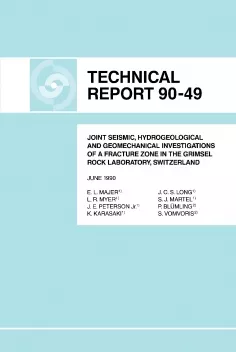
Technical Report NTB 90-49
Joint seismic, hydrogeological and geomechanical investigations of a fracture zone in the Grimsel Rock Laboatory, Switzerland
From 1987 to 1989 The United States Department of Energy (DOE) and the Swiss Cooperative for the Disposal of Nuclear Waste (Nagra) participated in an agreement to carry out experiments for understanding the effect of fractures in the storage and disposal of nuclear waste. As part of this joint work field and laboratory experiments were conducted at a controlled site in the Nagra underground Grimsel test site in Switzerland. The primary goal of the experiments in this fractured granite was to determine the fundamental nature of the propagation of seismic waves in fractured media, and to relate the seismological parameters to the hydrological parameters. The work is ultimately aimed at the characterization and monitoring of subsurface sites for the storage of nuclear waste. The seismic experiments utilized high frequency (1,000 to 10,000 Hz) signals in a crosshole configuration at scales of several tens of meters. Two-, three-, and four-sided tomographic images of the fractures and geologic structure were produced from over 60,000 ray paths through a 10 by 21 meter region bounded by to nearly horizontal boreholes and to tunnels. Intersecting this region was a dominant fracture zone which was the target of the investigations. In addition to these controlled seismic imaging experiments, laboratory work using core from this region was performed to establish the relation between fracture content, saturation, and seismic velocity and attenuation. In-situ geomechanical and hydrologic tests were carried out to determine the mechanical stiffness and conductivity of the fractures. The results indicate that both P-waves and S-waves can be used to map the location of fractures, both natural and induced from mining activities. In addition, it appears that the frequencies approaching several kilohertz, attenuation measurements are more useful than velocity measurements. At lower frequencies the opposite seems to be true. In addition, fractures that are open and hydrologically conductive are much more visible to seismic waves than non-conductive fractures.
